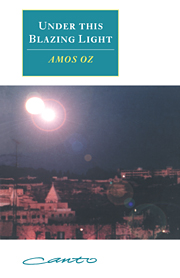Book contents
- Frontmatter
- Contents
- Translator's note
- Preface to the Hebrew edition
- Introduction
- Events and books
- Under this blazing light
- ‘Man is the sum total of all the sin and fire pent up in his bones’
- ‘A ridiculous miracle hanging over our heads’
- The State as reprisal
- A modest attempt to set out a theory
- The meaning of homeland
- The discreet charm of Zionism
- A.D. Gordon today
- Thoughts on the kibbutz
- The kibbutz at the present time
- How to be a socialist
- Munia Mandel's secret language
- Pinchas Lavon
- The lost garden
- An autobiographical note
- An alien city
- Like a gangster on the night of the long knives, but somewhat in a dream
- Notes
- Publication history
- Index of names
A modest attempt to set out a theory
Published online by Cambridge University Press: 07 September 2010
- Frontmatter
- Contents
- Translator's note
- Preface to the Hebrew edition
- Introduction
- Events and books
- Under this blazing light
- ‘Man is the sum total of all the sin and fire pent up in his bones’
- ‘A ridiculous miracle hanging over our heads’
- The State as reprisal
- A modest attempt to set out a theory
- The meaning of homeland
- The discreet charm of Zionism
- A.D. Gordon today
- Thoughts on the kibbutz
- The kibbutz at the present time
- How to be a socialist
- Munia Mandel's secret language
- Pinchas Lavon
- The lost garden
- An autobiographical note
- An alien city
- Like a gangster on the night of the long knives, but somewhat in a dream
- Notes
- Publication history
- Index of names
Summary
What is literature all about?
If one wished to give an extremely concise answer, which could serve as an entry in a short encyclopaedia, one could word it as follows:
Literature: A form of expression and communication by means of language, generally dealing with three set subjects in various contexts and combinations: 1. Sorrow or suffering. 2. Protest or complaint. 3. Consolation or semi-consolation or less, including submission. Full stop. It must also contain something new, either in the arrangement of the words and sentences, or in the arrangement of the subject-matter, or in some other way.
The following notes are intended for the reader who is not satisfied with this short description and requires further elucidation:
Sorrow: May be individual or collective, or both, interrelated, contrasted, one set against the other, etc., etc.
Protest or complaint: Either wistful, or irritable, or violent, or even rebellious.
Consolation or submission: Includes acceptance of punishment or suffering, willingness to be absorbed into the cosmic cycle, or resignation and subjugation of the will. Or reconciliation with one's fellow man or with some force or other. Or seeing the whole situation in a new light. Also includes religious illumination and the faith that lies beyond despair.
What is encompassed within this description of literature as a circle of sorrow – protest – consolation? Almost everything. Homer and Oedipus, Dante and Don Quixote, John Donne and King Lear, Andrei Bolkonski and Raskolnikov and the Three Sisters, Kafka, Hans Castorp, and those involved in trials and experiments at the present time.
- Type
- Chapter
- Information
- Under this Blazing Light , pp. 71 - 76Publisher: Cambridge University PressPrint publication year: 1995

